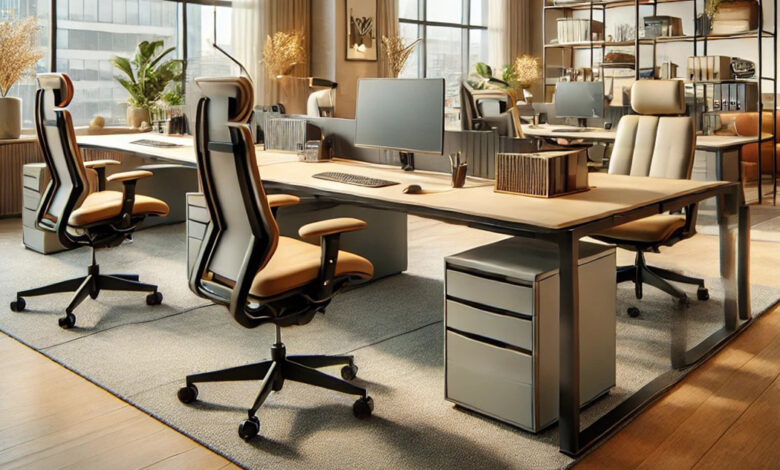How to Choose Office Chairs That Align with Your Sustainability Goals

In today’s world, sustainability is a growing priority for businesses, and one area that is often overlooked in sustainability efforts is office furniture. When it comes to choosing office furniture, selecting the right office chairs is just as important as any other piece of equipment in your workspace. The office chair, often an item that employees use for hours a day, can have a significant impact on both comfort and the environment.
Many organisations are now seeking out eco-friendly office furniture options, with a focus on sustainability, reducing carbon footprints, and sourcing ethical materials. Whether you’re outfitting a home office or updating your corporate space, choosing an office chair that aligns with your sustainability goals can make a real difference. This article will guide you through the essential factors to consider when selecting office chairs that help you meet your environmental targets while ensuring comfort, functionality, and durability.
Understanding Sustainability in Office Furniture
Sustainability in office furniture goes beyond just recycling or using fewer resources. It encompasses the entire lifecycle of a product, from the materials used in manufacturing to its disposal at the end of its life. A sustainable office chair should be made from responsibly sourced materials, designed to be durable, and, ideally, recyclable or biodegradable once it reaches the end of its life.
For businesses looking to reduce their environmental impact, choosing sustainable office furniture, including office chairs, can be a simple yet effective way to make a significant contribution to their sustainability goals. Companies are increasingly recognising the importance of investing in products that offer long-term value, both in terms of quality and environmental responsibility. Here are the key aspects to consider when choosing office chairs that align with your sustainability goals.
1. Material Sourcing and Eco-Friendly Fabrics
One of the first things to look at when choosing an office chair is the materials used in its construction. The fabric, frame, padding, and other components should be sourced responsibly to ensure that the chair has a minimal environmental impact.
Frame Material
The frame of the office chair is typically made from metal or plastic. While metals such as steel are durable and recyclable, they can also be energy-intensive to produce. Aluminium is a more energy-efficient option, being lighter and requiring less energy in the manufacturing process. Look for office chairs made from recycled aluminium or steel, as these materials reduce the need for raw material extraction and lessen environmental harm.
Upholstery and Fabrics
The fabric used for upholstery plays a crucial role in the sustainability of an office chair. Many office chairs are upholstered in synthetic materials such as PVC or polyurethane, which are derived from petroleum and can take centuries to decompose. Eco-friendly office chairs often feature natural fibres such as organic cotton, wool, or linen, which are renewable and biodegradable.
Alternatively, some office chairs are made from recycled materials, such as recycled polyester, which is often sourced from post-consumer waste like plastic bottles. This not only helps reduce plastic waste but also lessens the environmental impact associated with producing new materials. Be sure to check if the fabric has certifications like OEKO-TEX® Standard 100, which ensures it is free from harmful chemicals and dyes.
2. Durability and Longevity
A key element of sustainability is ensuring that the product lasts as long as possible. Office chairs should be durable enough to withstand years of daily use without breaking down. The longer the chair lasts, the less frequently it needs to be replaced, reducing the demand for new resources and the amount of waste produced.
When selecting an office chair, consider one made with high-quality components that can stand the test of time. Check for product warranties and certifications, which can indicate the chair’s longevity. Some chairs come with replaceable parts, allowing for easy repairs instead of discarding the entire chair when a component breaks.
Additionally, investing in ergonomic chairs that encourage good posture and reduce the risk of injury can contribute to a healthier and more productive workplace, which further supports sustainability by reducing the need for healthcare-related expenses and worker compensation claims.
3. Recyclability and End-of-Life Considerations
An often-overlooked aspect of sustainable office furniture is the end-of-life stage. Once an office chair reaches the end of its useful life, it should be easy to recycle or repurpose. Look for office chairs that are designed with recyclability in mind, meaning they are made from materials that can be easily disassembled and recycled. Ideally, the chair should be made from a single material or from materials that can be easily separated.
Some manufacturers also offer take-back programmes, where they will collect old chairs and recycle them for you. This can be a great way to ensure that your old office furniture doesn’t end up in a landfill. Additionally, certain office chairs are designed to be disassembled easily, allowing individual components such as the frame, fabric, and wheels to be recycled separately.
4. Energy-Efficient Manufacturing Processes
The manufacturing process of office chairs also plays a significant role in their overall environmental impact. Many companies are now focusing on reducing their carbon footprint by adopting energy-efficient manufacturing practices. Look for office chairs that are produced using renewable energy sources or low-carbon manufacturing processes.
Some manufacturers also focus on reducing waste during the production process, using techniques such as lean manufacturing to minimise the use of raw materials and cut down on excess packaging. These efforts help reduce the overall environmental impact of producing office furniture.
5. Certifications and Third-Party Approvals
Certifications can be a great way to ensure that the office chair you are purchasing meets environmental and sustainability standards. Look for eco-labels and certifications from recognised organisations that focus on sustainability, such as:
- BIFMA Level Certification: This is a sustainability standard for office furniture, which assesses the environmental impact of products throughout their life cycle.
- Cradle to Cradle Certification: This certification evaluates products based on their material health, recyclability, and overall sustainability.
- Forest Stewardship Council (FSC) Certification: This ensures that wood and other forestry products used in office furniture come from responsibly managed forests.
By choosing office chairs that carry these or similar certifications, you can be confident that they have been tested for environmental and social responsibility.
6. Comfort and Ergonomics
While sustainability is a key factor, it’s important to also consider the comfort and ergonomic features of your office chair. A sustainable office chair should not compromise on quality or comfort. In fact, ergonomics are essential for creating a productive and healthy workplace, which can contribute to long-term sustainability goals by reducing absenteeism and improving employee well-being.
Look for office chairs that offer adjustable features such as seat height, backrest angle, and lumbar support to ensure that each employee can customise the chair to their needs. This will help prevent discomfort and strain, supporting a more sustainable and efficient workspace.
Conclusion
Choosing office chairs that align with your sustainability goals is an essential step towards creating a more eco-conscious workspace. By considering factors such as material sourcing, durability, recyclability, and energy-efficient manufacturing, you can make a significant positive impact on both the environment and your business.
Investing in office furniture that is built to last, made from eco-friendly materials, and designed for easy recycling can help reduce waste, lower your carbon footprint, and promote a healthier, more comfortable work environment for your team. With so many sustainable options available, there’s no reason why sustainability and comfort cannot go hand in hand when choosing the right office chair.




